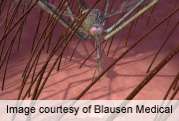Some 2009-2010 cases originated in Key West mosquitoes, not from travelers, CDC says.
(HealthDay)—Some people who fell prey to a 2009-2010 outbreak of dengue fever in Florida carried a particular viral strain that they did not bring into the country from a recent trip abroad, according to a fresh genetic analysis conducted by the U.S. Centers for Disease Control and Prevention.
To date, most cases of dengue fever on American soil have typically involved travelers who "import" the painful mosquito-borne disease after having been bitten elsewhere. But though the disease cannot move from person to person, mosquitoes are able to pick up dengue from infected patients and, in turn, spread the disease among a local populace.
The CDC's viral fingerprinting of Key West, Fla., dengue patients therefore raises the specter that a disease more commonly found in parts of Africa, the Caribbean, South America and Asia might be gaining traction among North American mosquito populations.
"Florida has the mosquitoes that transmit dengue and the climate to sustain these mosquitoes all year around," cautioned study lead author Jorge Munoz-Jordan. "So, there is potential for the dengue virus to be transmitted locally, and cause dengue outbreaks like the ones we saw in Key West in 2009 and 2010," he said.
"Every year more countries add another one of the dengue virus subtypes to their lists of locally transmitted viruses, and this could be the case with Florida," said Munoz-Jordan, chief of CDC's molecular diagnostics activity in the dengue branch of the division of vector-borne disease.
He and his colleagues report their findings in the April issue of CDC's Emerging Infectious Diseases.
Dengue fever is the most widespread mosquito-borne viral disease in the world, now found in roughly 100 countries, the study authors noted.
That said, until the 2009-2010 southern Florida outbreak, the United States had remained basically dengue-free for more than half a century.
Ultimately, 93 patients in the Key West area alone were diagnosed with the disease during the outbreak, which seemingly ended in 2010, with no new cases reported in 2011.
But the lack of later cases does not give experts much comfort. The reason: 75 percent of infected patients show no symptoms, and the large "house mosquito" population in the region remains a disease-transmitting disaster waiting to happen.
To try and get a handle on just how serious that risk might be, the CDC team looked at blood samples from 16 of Florida's 67 counties, collected from dengue patients by the Florida Department of Health.
Rigorous genetic testing revealed what researchers feared: the identification of a local Key West strain among dengue patients who had not recently traveled outside the United States.
The team was able to trace the new Key West strain back to its original imported source: a Central American viral strain initially brought into Florida by patients infected in that region. But they stressed that as the local mosquito population acquired the virus from this first round of patients, it developed into a distinct strain of its own. In turn, the new strain was passed on to local residents who had not recently visited Central America.
The upshot: In some cases the dengue fever "smoking gun" was the local Florida mosquito population, rather than mosquitoes from other regions.
"(But) the Key West virus strain did not resemble those found elsewhere in Florida," said Carina Blackmore, chief of the Florida Department of Health's bureau of environmental public health medicine in Tallahassee. This, she said, implies that while patients in the Key West region had indeed contracted dengue from local mosquito carriers, patients in other parts of the state got sick through more typical means: travel abroad.
In terms of what to do about locally driven disease risk, Dr. Marc Siegel, a clinical associate professor of medicine in the department of medicine at NYU Langone Medical Center in New York City, said that the question is how best to deal with a Florida landscape that is a "notorious breeding center" for mosquitoes.
"Mosquitoes don't really ride on planes," he noted. "The issue here is that the mosquito population is growing in the swamp areas there. This is all about these breeding grounds, which help the disease get a footing in the local area," Siegel said.
"But then the question is, how do you handle an environment that gives rise to this kind of disease spread?" added Siegel, who is the author of numerous books on infectious diseases and contagions. "It's a difficult problem that will require going step by step. Spraying is one route, but it's not always the answer. It may, in fact, become an issue of getting rid of the breeding areas themselves altogether."
More information: For more about dengue fever, visit the U.S. Centers for Disease Control and Prevention.
Journal information: Emerging Infectious Diseases
Health News Copyright © 2013 HealthDay. All rights reserved.


















